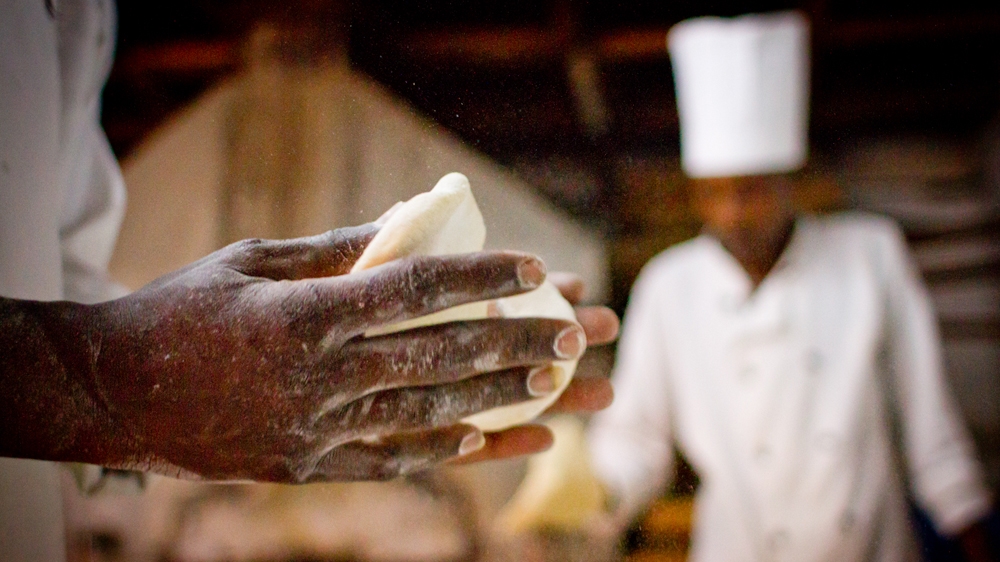Nairobi’s immigrant cookbook
February 17, 2016
Nairobi, Kenya – On a drizzly afternoon in Nairobi, Sandra Zhao sits at a hand-crafted wooden table sipping green tea from a ceramic Japanese cup. Across from her, the man who built the table and the restaurant that houses it describes the different Japanese delicacies as they arrive.
First there is pink-coloured tamago, a Japanese appetiser made of egg and dashi, and a light miso soup. Then comes a plate of salmon maki. Next is the main affair: Tantanmen (spicy noodle), a rich brown broth made of fish stock with home-made noodles that the restaurant's owner, Yuki Kashiwagi, says is a favourite Japanese late-night food. And last, a plate of Japanese pancakes, or Okonomiyaki, topped with flakes of dried tuna that are so thin they wiggle in the afternoon breeze. “I love that!,” Zhao exclaims. “I know – that's why I ordered it,” says Kashiwagi.
Zhao, after all, has been frequenting Kashiwagi's restaurant since the day it opened. Creator of the Nairobi specialty cupcake startup SugarPie, she is teaming up with another American foodie – cupcake collaborator and founder of Nairobi's Open Table Cooking School April Dodd – to publish a cookbook that will feature recipes from 30 Nairobi immigrant restaurant owners and the stories of what brought them here. Called Im/migrant Nairobi: A Cookbook, the project will feature Kashiwagi's restaurant.
A continental hub for all manner of tech start-ups, NGOs, UN agencies and more, Nairobi is one of the most diverse cities in Africa. Indians, who began immigrating to Kenya's coast more than a century ago, introduced spices, chai and chapatti that have found their way into mainstream Kenyan fare. Ethiopians who escaped the rule of Haile Selassie operate restaurants that adhere closely to traditional Ethiopian recipes and ceremonies. Recently, Chinese, Korean, Japanese and other Asian immigrants are reigniting the trend. If Kenya is East Africa's country for foreigners, then Nairobi is the Mecca for their culinary traditions.
An American whose parents immigrated from China, Zhao became fascinated by Nairobi's culinary scene when she began dining at a Chinese-owned restaurant and safari company. One dish in particular reminded her of her family's cooking back in China.
“There's this dish that's steamed pork … it's coated in toasted rice,” says Zhao. “It's a complicated dish to make. You can't order that in a Chinese restaurant in America. It's too complicated.”
Upon encountering the dish in Kenya, Zhao thought, “Who are these people here making the food that speaks to me?”
She began visiting different restaurants, returning time and again to speak to the owners, learn about what brought them to Kenya, and taste their latest creations.
“You go to these places and people start to notice you,” Zhao says. “After four years you're the ‘Chinese' girl who keeps coming in to order the falafel.”
Some immigrants, she learned, came here as teenagers on holiday, or just out of university. Others came as construction workers. Many European immigrants came looking for excitement. “As opposed to south Asian immigrants who came because they didn't have a choice,” says Zhao. “They came under the British colonial government, because they were working on the railroads, or they followed their family here.”
For Indians, Kenya was one of the few countries where you could get a visa upon arrival. In 1987, two Indians who had been washing dishes and cleaning bathrooms made their way to Kenya on holiday, and decided to stay, finding jobs as cooks in the hotel's kitchen. They later quit to open what many agree is the best Indian restaurant in town. “Now one of their children is a doctor, one is an engineer,” says Zhao. “Would that have happened if they stayed in India?
“The immigrant ethos is you go to make it and you stay until you make it, and you send money home and you think about going home – but you never really do.”
READ MORE: What food means to me
Many of Nairobi's best eating places are African. There are West African restaurants, Sudanese, Ethiopian and Somali. The founder of one Somali restaurant grew up herding camels in northern Kenya. Now he is a successful Nairobi businessman.
While most immigrants arrive here voluntarily, some come fleeing strife elsewhere. The owners of a popular Chinese Hot Pot restaurant immigrated to Burundi decades ago to open a clothing factory. When civil war broke out there, in 1993, they fled. At the airport they met another Chinese person who told them Nairobi would be a safe place to start a business, so they bought their tickets on the spot. “That's flying by the seat of your pants,” says Zhao.
Some immigrant food entrepreneurs run into challenges that Kenyans do not. One Somali restaurant Zhao had hoped to feature closed unexpectedly because of “immigration issues”. That is probably a euphemism for the routine harassment, arbitrary arrests and extortion that some Kenyan police enact upon Ethiopian and Somali immigrants under the ruse of fighting terrorism.
“Particularly for Ethiopians and Somalis and other Africans – they're vulnerable in a way that I am not,” says Zhao.
Working with the locals
As a child growing up in Osaka, Japan, each Saturday Kashiwagi's mother would cook him a plate of the tuna-topped pancakes that Zhao so enjoys.
An athlete who was in the national youth baseball team, Kashiwagi left Japan when he was 22 to teach physical education in the rural village of Samfya, Zambia, as part of Japan's version of the Peace Corps. It was there that he learned English and became fascinated by East African culture.
When his service ended, looking for a way to stay in Africa, Kashiwagi persuaded a Japanese car import company to open a shop in Mombasa, a major port city on the coast of Kenya. “It was a big pressure,” he says. “And I could not concentrate on my dreams.” Those dreams involved opening his own restaurant and “giving back” to the people who had played host to him for all these years. “I wanted to help them, and the easiest way was to make employment.”
He set his sights on a cosmopolitan city with a diverse array of immigrants and visitors from all over the world. “In Nairobi, the economy was coming up with foreigners,” says Kashiwagi.
It would be difficult to imagine someone better prepared for the job. Growing up, Kashiwagi had worked as a sushi chef and also as a carpenter. He built his restaurant – its tables, benches, the bar, and a wooden loft with a sort of VIP table – from scratch in only seven days with the help of five Japanese friends who flew over for the task.
When it opened in 2014, his was the only Japanese restaurant in Nairobi owned by an actual Japanese person. The rest, according to him and to Zhao, are operated by Korean or other Asian families. “They want to take advantage of the Japanese name. But it's not Japanese taste,” says Kashiwagi.
These other restaurants go by Japanese names – Tokyo, Furusato, Teriyaki Japan. In contrast, Kashiwagi named his place using the Swahili word Cheka, which means laugh. “The most important thing in life must be fun,” he says.
NAIROBI'S STREET FOOD: Nourishment and making a living
But starting an authentic Japanese restaurant in Kenya was hard work. While in Mombasa, Kashiwagi began training more than 20 fisherman how to catch and preserve seafood in keeping with Japanese customs. Often they would fish using spears, but that would cause the fish's blood to drain into the body, and the meat would lose its freshness. He asked them to fish with nets and hooks instead, and taught them how to use wire to extract blood from inside the fish's bones to better preserve it. Today, most of his restaurant's seafood comes fresh from Kenya's coast: yellow snapper, tuna, squid, and yellow jack, which is a type of mackerel.
To keep the place authentic, Kashiwagi imports his soy sauce from Japan and cooks his rice according to a secret personal recipe that keeps it soft and moist. He says the trick is how long you soak the rice, and how many times you wash it. He also started growing cabbage, Daikon radish, and shiso seeds on a farm north of Nairobi.
Kashiwagi says his restaurant is Izakaya style, which means he serves both sushi and other Japanese mainstays. Traditionally in Japan, different types of food were served at different restaurants. But Izakaya is a product of our time. “Our generation wants to eat everything at once,” Zhao explains.
Although it is difficult to confirm, Kashiwagi estimates that there are fewer than 1,000 Japanese immigrants living in Nairobi. He says most work in private enterprise, some are diplomats, and a few dozen are volunteers. But he is not just tailoring his cuisine to the Japanese. At one point he interrupts his lunch, jumping to his feet to walk to the door a table of Korean guests who just finished dining. He says he persuaded them to come here after playing against them in a recent baseball match.
To attract customers, Kashiwagi draws upon his athletic past: He plays pickup baseball, basketball, and other sports around town. He says if he plays well enough, people end up asking him where he is from and what he is doing here, so he tells them to stop at his restaurant.
Still, Kashiwagi's ultimate goal is to persuade Kenyans to frequent his place. For now, he says most Kenyan customers go for the Terryaki chicken – one of the least traditional items on the menu. They shy away from the seafood. For lunch, even his own staff prefers Kenyan chapatti to sushi.
READ MORE: The rise of Pakistan's ‘burger' generation
Most of his 20 employees live in the nearby working-class neighbourhood of Kangemi. Even though Kangemi is on a direct matatu (public transport) route to the restaurant, Kashiwagi pays a driver to shuttle his employees directly to and from their homes each day.
“They have a right to get good treatment. Then they will appreciate the company,” he says. That mentality carries over to the service he provides to his customers.
When a Kenyan waiter delivers Zhao's chopsticks, she lays them out horizontally with the top ends resting next to Zhao's right hand. But the server is careful to place Kashiwagi's chopsticks the opposite way – he is left-handed.
“If you can remember that customer is left-handed, that is good,” Kashiwagi explains. “Like in Japan, I respect you, so you come again.”
Kashiwagi returns to Japan just once a year. As he dines with Zhao, his wife is studying English in the wooden loft inside. Kashiwagi says there is one thing an immigrant restaurant owner must never forget: “We are foreigners. If you forget to respect the local people, they will look down on you.”
A Norwegian Lebanese restaurant owner settles in
Magne Albrigtsen's journey to Kenya was a long one. He worked for more than 15 years for the United Nations, first as an officer stationed all over the Middle East and Africa, and later as a communications engineer. He met his wife in 1980 on an assignment in Lebanon.
To Albrigtsen, Kenya had always been an unknown place – some exotic country where rich Norwegians went on holiday. When he landed in Nairobi in 1992 for the first time, he says it was “a paradise”.
“We were moving every year, and the kids were growing older,” he recalls. “We were looking for a stable environment,” and Kenya provided it.
At the time, Nairobi had few options when it came to foreign cuisine.
With his wife's knowledge of Lebanese fare, they opened a restaurant together with a Kenyan and a Lebanese partner. They named it Cedar's, after the Lebanon Cedar Tree.
But some critical ingredients were difficult to come by. “There was no parsley in this country when we came here,” Albrigtsen says, parsley being one of the primary spices used in Lebanese food. “I brought the seeds from Norway. I gave it to some farmers in Limuru.”
Sitting at a table on the open-air front patio of his restaurant, Albrigtsen tells Zhao that he can now buy parsley just about anywhere. Tahini (sesame seed paste) is one of the only items he still has to import. “But sesame seeds were native here to East Africa!” says Zhao. “Yes, but South Sudan now is a mess,” Albrigtsen replies.
The son of an arctic fisherman, Albrigtsen boasts about Norway's rich coastline and the robust fishing industry that his father was a part of. He pulls out a phone and uses Google Maps to zoom in on his home village, Bo, Nordland, on an island far north of the Arctic Circle on the Norwegian Sea. To this day, he imports his salmon – perhaps the glaring exception to the restaurant's authentic Lebanese fare – from these waters.
Albrigtsen has been operating his restaurant in Nairobi for so long that he struggles to remember the exact year it opened. He calls over a Kenyan bartender who goes by the nickname Kioko. It was 1998 – October, 1998, Kioko says. Kioko would know – he was working here the day it opened, as were many of the current staff – Cedar's prides itself in training and treating its staff well, resulting in precious little turnover.
Inside the kitchen, chefs specialise. One man is at the fryer, another grills dozens of chicken wings. Women do most of the tricky handiwork – rolling or shaping thousands of Kebbe (minced meat), Samboucik and Fatayer (pastries), and falafel (chick peas) each day. Today they are preparing a catering order for the Qatari embassy.
As with Kashiwagi's restaurant, when Albrigtsen opened Cedar's, he says few of his customers were Kenyan. He had to put ads out on the radio. It was not until “they realised we had kuku (chicken), but just called it something else”, that Kenyans finally began coming. “Kenyans are like everyone else – they love chicken wings.” To this day, wings are Cedar's most popular item.
One thing that keeps Kenyans coming back for more? The portions. Kenyans are accustomed to eating what Zhao calls “subsistence foods” – filling dishes like ugali, a dense substance made of cornflower. In keeping with that tradition, Albrigtsen serves his foods in such large portions that to leave on an empty stomach would be impossible.
WATCH: Al Jazeera's food series, AJEats
If you ever get the chance to head out for dinner at Nairobi's immigrant restaurants, Zhao has a few tips. “Restaurants will have these extensive menus – pages and pages with huge pictures. But you just need to ask what's fresh today – what are you eating?” she says.
Better yet, take a look around the room. “A lot of restaurants substitute as people's personal homes. You're eating, they're eating, their kids are eating.” Pull up a chair and tell your server you'll have what they are having.
Visit the Im/migrant Nairobi: A Cookbook project's website, where Zhao also publishes blog posts and sneak previews of the book.
The post Nairobi's immigrant cookbook appeared first on African Media Agency.
Source:: http://amediaagency.com/nairobis-immigrant-cookbook/

















